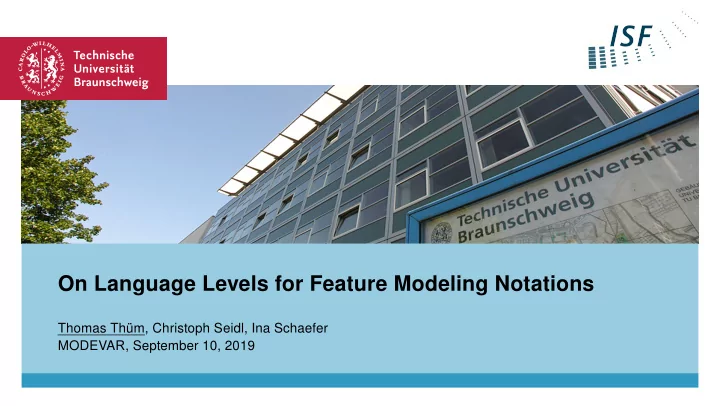

On Language Levels for Feature Modeling Notations Thomas Thüm, Christoph Seidl, Ina Schaefer MODEVAR, September 10, 2019
Part I The Need for Variability Modeling
The Situation 110 Years Ago: Ford Model T „Any customer can have a car painted any color that he wants so long as it is black.“ — Henry Ford, 1909 Thomas Thüm On Language Levels for Feature Modeling Notations Slide 3
Today: Every Second Car has a Unique Configuration Thomas Thüm On Language Levels for Feature Modeling Notations Slide 4
Constraints Among Features are Challenging Thomas Thüm On Language Levels for Feature Modeling Notations Slide 5
Constraints Among Features are Challenging A car without Microsoft Office 365?!? Thomas Thüm On Language Levels for Feature Modeling Notations Slide 5
Constraints Among Features are Challenging Thomas Thüm On Language Levels for Feature Modeling Notations Slide 6
Constraints Among Features are Challenging Thomas Thüm On Language Levels for Feature Modeling Notations Slide 6
Variability Models as Central Knowledge Database Thomas Thüm On Language Levels for Feature Modeling Notations Slide 7
Part II The Need for Variability Analyses
Real-World Variability Modeling · · · · · · . . . Thousands of features and constraints, increases over time No modularity or information hiding Temporal elements Typically not modeled with feature models Thomas Thüm On Language Levels for Feature Modeling Notations Slide 9
One Product Line Specified with Different "Languages" Thomas Thüm On Language Levels for Feature Modeling Notations Slide 10
Variability Modeling par Excellence Thomas Thüm On Language Levels for Feature Modeling Notations Slide 11
Variability Modeling par Excellence Thomas Thüm On Language Levels for Feature Modeling Notations Slide 11
Variability Modeling par Excellence Thomas Thüm On Language Levels for Feature Modeling Notations Slide 11
Variability Modeling par Excellence Thomas Thüm On Language Levels for Feature Modeling Notations Slide 11
Variability Modeling par Excellence Thomas Thüm On Language Levels for Feature Modeling Notations Slide 11
Variability Modeling par Excellence Thomas Thüm On Language Levels for Feature Modeling Notations Slide 11
Clone-and-Own of Variability Models Thomas Thüm On Language Levels for Feature Modeling Notations Slide 12
Clone-and-Own of Variability Models Thomas Thüm On Language Levels for Feature Modeling Notations Slide 12
Anomalies in Variability Models Thomas Thüm On Language Levels for Feature Modeling Notations Slide 13
Anomalies in Variability Models Thomas Thüm On Language Levels for Feature Modeling Notations Slide 13
Configuration Spaces Tend to Grow Over Time 1,00E+27 1,00E+24 Number of Valid Configurations 1,00E+21 1,00E+18 (logarithmic) 1,00E+15 1,00E+12 1,00E+09 1,00E+06 1,00E+03 1,00E+00 2013 2014 2015 2016 2017 2018 2019 2020 2021 Year Thomas Thüm On Language Levels for Feature Modeling Notations Slide 14
Part III Criteria for Language Design
Why to Use SAT Solvers for Variability Analysis? Thomas Thüm On Language Levels for Feature Modeling Notations Slide 16
Missing Analyses for Feature Attributes Thomas Thüm On Language Levels for Feature Modeling Notations Slide 17
Page 1 of 1 Industry Demands for Modularity and Branching Thomas Thüm On Language Levels for Feature Modeling Notations Slide 18 file:///C:/Users/tthuem/git/Paper/pics/versioncontrol/git-branches.svg 11/03/2019
Language Levels for Feature Modeling Notations Major Levels: expressiveness aligns with solver classes propositional logic: SAT, binary decision diagram (BDD), #SAT, . . . first-order logic: satisfiable modulo theory (SMT), constraint satisfaction problem (CSP)?, . . . more needed? answer set programming (ASP)? pseudo-boolean satisfiability (PB-SAT)? . . . Thomas Thüm On Language Levels for Feature Modeling Notations Slide 19
Language Levels for Feature Modeling Notations Major Levels: expressiveness aligns with solver classes propositional logic: SAT, binary decision diagram (BDD), #SAT, . . . first-order logic: satisfiable modulo theory (SMT), constraint satisfaction problem (CSP)?, . . . more needed? answer set programming (ASP)? pseudo-boolean satisfiability (PB-SAT)? . . . Minor Levels: differing expressiveness within major levels align with expressiveness of state-of-the-art languages meet requirements from typical application domains example: supported tree and cross-tree constraints Thomas Thüm On Language Levels for Feature Modeling Notations Slide 19
Language Levels for Feature Modeling Notations Major Levels: expressiveness aligns with solver classes propositional logic: SAT, binary decision diagram (BDD), #SAT, . . . first-order logic: satisfiable modulo theory (SMT), constraint satisfaction problem (CSP)?, . . . more needed? answer set programming (ASP)? pseudo-boolean satisfiability (PB-SAT)? . . . Minor Levels: differing expressiveness within major levels align with expressiveness of state-of-the-art languages meet requirements from typical application domains example: supported tree and cross-tree constraints Orthogonal Levels: independent of expressiveness Modularity with feature-model interfaces or slicing Feature versions and temporal validity with hyper and temporal feature models Thomas Thüm On Language Levels for Feature Modeling Notations Slide 19
Part I The Situation 110 Years Ago: Ford Model T Today: Every Second Car has a Unique Configuration Constraints Among Features are Challenging Variability Models as Central Knowledge Database
Part II Real-World Variability Modeling One Product Line Specified with Different "Languages" Variability Modeling par Excellence Clone-and-Own of Variability Models Anomalies in Variability Models Configuration Spaces Tend to Grow Over Time
Part III Why to Use SAT Solvers for Variability Analysis? Missing Analyses for Feature Attributes Industry Demands for Modularity and Branching Language Levels for Feature Modeling Notations
On Language Levels for Feature Modeling Notations Part I Part II Part III
Recommend
More recommend